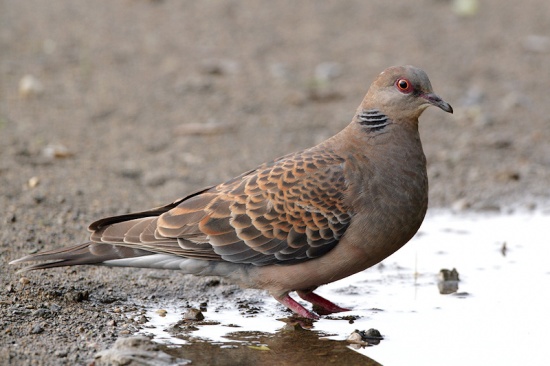(References updated) |
(Picture showing rear plumage & spread tail) |
||
| Line 7: | Line 7: | ||
*Black and white neck patches | *Black and white neck patches | ||
*Long, grey, white-tipped tail | *Long, grey, white-tipped tail | ||
| + | [[Image:DSC8337.jpg|thumb|350px|right|Photo by {{user|Stoop|Stoop}}<br />Fukushimagata, Niigata, [[Japan]], July 2011]] | ||
*Red legs<br /> | *Red legs<br /> | ||
Sexes are similar | Sexes are similar | ||
| − | |||
====Similar species==== | ====Similar species==== | ||
in the western part of the range of Oriental Turtle-Dove and when this one occurs as a vagrant to [[Europe]], [[European Turtle-Dove]] is a relevant bird to look at. | in the western part of the range of Oriental Turtle-Dove and when this one occurs as a vagrant to [[Europe]], [[European Turtle-Dove]] is a relevant bird to look at. | ||
| Line 16: | Line 16: | ||
==Taxonomy== | ==Taxonomy== | ||
====Subspecies==== | ====Subspecies==== | ||
| + | [[Image:269A1422 Edited-1.jpg|thumb|350px|right|Photo by {{user|letsbefrank|letsbefrank}}<br />Tonboike Park, Kishiwada, [[Japan]], January 2016]] | ||
There are six subspecies generally recognised<sup>[[#References|[1]]]</sup>: | There are six subspecies generally recognised<sup>[[#References|[1]]]</sup>: | ||
*''S. o. meena'': | *''S. o. meena'': | ||
Revision as of 21:19, 7 February 2016
Alternative name: Rufous Turtle Dove
- Streptopelia orientalis
Identification
33–35 cm (13-14 inches)
- Scaley buff-brown on back and wings (the feathers are black fringed with buff, grey, or red
- Black and white neck patches
- Long, grey, white-tipped tail
- Red legs
Sexes are similar
Similar species
in the western part of the range of Oriental Turtle-Dove and when this one occurs as a vagrant to Europe, European Turtle-Dove is a relevant bird to look at.
Distribution
Asia: found in Siberia, Iran, India, China, Korea, south-east Asia, and southern Japan.
Taxonomy
Subspecies
There are six subspecies generally recognised[1]:
- S. o. meena:
- South-western Siberia to Iran, Afghanistan, Kashmir and Nepal
- S. o. orientalis:
- S. o. stimpsoni :
- Ryukyu Islands
- S. o. orii:
- S. o. erythrocephala:
- Peninsula India
- S. o. agricola:
Habitat
Forests and light woodland, city parks and gardens.
Behaviour
Diet
Their diet is mostly vegetarian, consisting of cereals and pine seeds, also shoots of various plants, including bamboo and herbs.
Breeding
The clutch consists of two white eggs which are laid in a twiggy tree nest.
References
- Clements, J. F., T. S. Schulenberg, M. J. Iliff, D. Roberson, T. A. Fredericks, B. L. Sullivan, and C. L. Wood. 2015. The eBird/Clements checklist of birds of the world: v2015, with updates to August 2015. Downloaded from http://www.birds.cornell.edu/clementschecklist/download/
- Birdforum thread discussing identification of European Turtle-Dove vs meena Oriental Turtle-Dove
- Avibase
- Wikipedia
- Handbook of the Birds of the World Alive (retrieved June 2015)
Recommended Citation
- BirdForum Opus contributors. (2024) Oriental Turtle Dove. In: BirdForum, the forum for wild birds and birding. Retrieved 23 November 2024 from https://www.birdforum.net/opus/Oriental_Turtle_Dove
External Links






